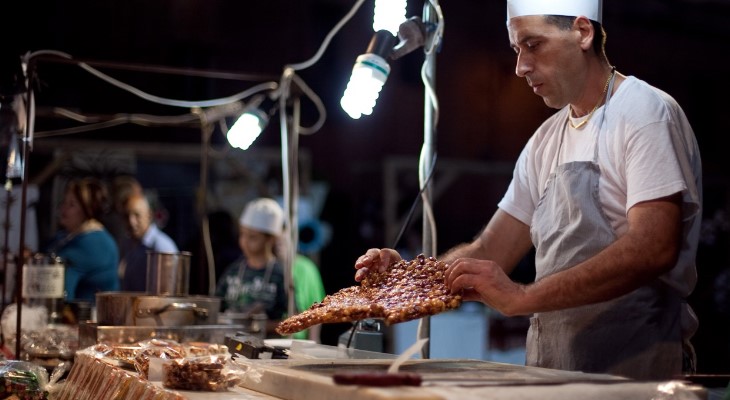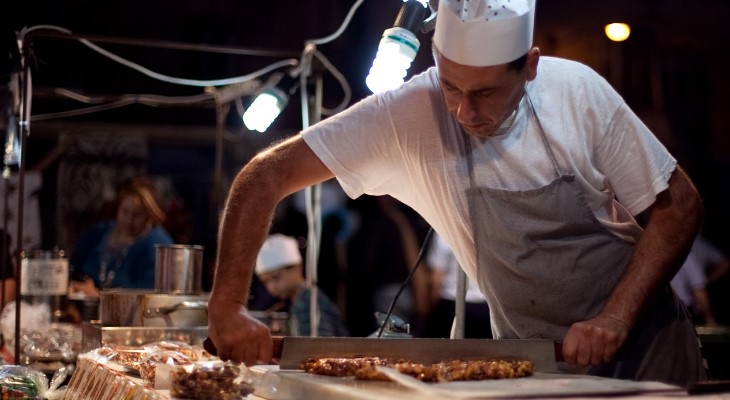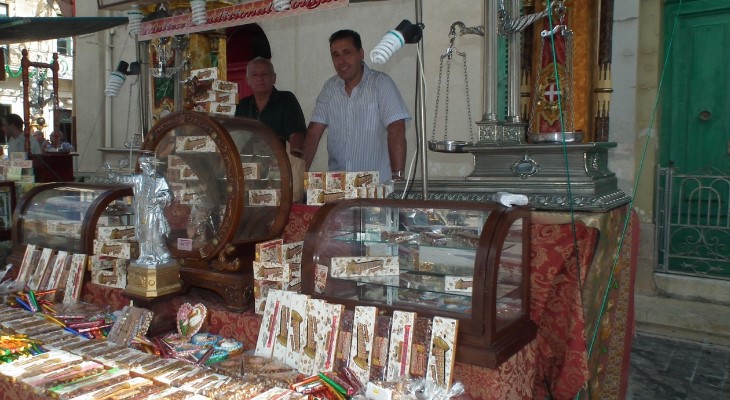It’s not a festa without nougat: a centuries-old tradition that is as much a part of the village feast as fireworks, brass band marches and the statue of the patron saint.
Summer in Malta is punctuated by village feasts celebrating their parish’s patron saint. But these feasts are not just an excuse for a giant party and some spectacular fireworks (although we sure love those). The festa brings the community together. Families from near and far get together and emigrants time their visit back home to coincide with the festa. People throw open the doors to their homes to welcome visitors as the whole town is swept up in a frenzy of celebration and merriment.
I remember as a child the excitement and anticipation surrounding the festa. The house would be cleaned from top to bottom, everything would be shiny and resplendent. New clothes were bought or made specifically for the festa.

Robert Caruana making brittle dark "black" nougat
And of course, at the centre of any Maltese celebration is food. Our generous hospitality extends to generous portions of food because, as I have often tried to explain to my English husband who still balks at the size of the timpana starter, it would be considered rude and downright stingy to give small portions to guests.
A celebratory festa lunch or dinner is the central event for any family, and there would undoubtedly be a table groaning with delicious food. A chicken or pork roast accompanied by oven baked potatoes flavoured with fennel seeds preceded by a starter of baked macaroni or timpana. Or possibly rabbit, either fried in garlic or stewed in a rich tomato sauce which is then used to make spaghetti with rabbit sauce.
And for dessert? Well, that can only be nougat, or qubbajt as we call it in Maltese. Perennially associated with the festa, nougat has stood the test of time and competition from international alternatives such as doughnuts and candy floss. As one of the eminent Maltese folklorists Joseph Cassar Pullicino famously put it “a feast without nougat is not a feast” (“Festa bla qubbajd mhix festa”).
Nougat has been a part of Malta’s culinary heritage for centuries, possibly introduced during the island’s Arabic rule. This ancient almond and honey (or sugar) based confection is found in several southern European countries where it is known as turrón in Spain, torró in Cataluña, torrone in Italy, pasteli in Greece and cubbaita in Sicily, a term derived from the Arabic qubbayt from which the Maltese version comes. It is thought that nougat was part of the medieval Arabic culinary tradition in Spain and Sicily, which eventually made it to Malta.
The earliest recorded references to a cobaytaro (nougat seller) dates back to the early years of the rule of the Order of St John (1530-1798). Another of Malta’s famous writers, the 18th century philosopher and linguist Mikiel Anton Vassalli described the key ingredients for a type of nougat made during his time as consisting of a mixture made from sesame seeds, almonds, honey and sugar producing a brittle type of toffee known as qubbajt tal-penit. And it seems that the traditional practice of turning out the searing confection onto a marble slab to cool before cutting into smaller portions dates back to this period too.

Robert Caruana
Nougat, like any other food, was a social marker and there were two different types of the sweet to suit different budgets, made from 'white' and 'black' honey with the latter, commonly known as melenegra normally consumed by the poorer people.
Tradition dictated that a groom had to buy a piece of nougat for his bride as a sign of affection, especially during the feast of St Peter and St Paul known as Mnarja, which is celebrated on 29th June and was the one feast that every groom had to promise to take his new wife to. This link between nougat and courtship was even immortalised in folk songs.
Today’s brides are more likely to expect other kinds of gifts from their betrothed, but nougat is still considered to be a special present. Confectioner Robert Caruana has been in the nougat business all his life, and runs the well-known Iz-Zebbugi Hawn (the man from Zebbug is here) stalls which have been part of every festa in all villages since 1948. He explains it is still a tradition for people to buy a piece of nougat to share with their colleagues at work or to present as a thank you gift to their family doctor or lawyer.

Robert Caruana - the iconic nougat stall complete with traditional weighing scales
They make two different types of nougat. The soft, also known as white nougat, is made from a mixture of egg white, sugar, water candied fruit and glucose while the hard nougat is a combination of almonds, hazelnuts, cashews, sesame seeds, toffee and caramel, and when ready is brittle and dark, and is therefore known as black nougat. Robert says the white nougat is definitely more popular, although festa parishioners in Mellieha and Gozo tend to prefer the black one. Soft nougat is sometimes available in creative colours and flavours such as banana, strawberry, orange, mint or chocolate.
Nougat sellers of long standing are all family concerns and, over the years, have become household names. However, some are now dying out, mainly because family members are not continuing the business.
“Nougat making is in my blood. I grew up in the confectionary watching my father and others making nougat. I have two sons, aged 23 and 15, and I hope that one day they will inherit the business and keep it going like I inherited it from my father,” says Robert.
On busy days in summer, the entire family gets involved. “We cook nougat from Monday to Friday and then on Saturday and Sunday we’re out at the feasts selling the freshly made nougat. We don’t make nougat from months ahead because the nuts go stale. In Summer we work non-stop, seven days a week,” reveals Robert.
Nougat is displayed and sold from distinctive wooden tables, and Robert will have as many as eight stalls at his local feast in Zebbug. Look out for these decorated tables laden with eye-catching sweet confections. If the exuberance and joy of a Maltese festa could be packaged and taken home, it would have to be in the form of a piece of sweet local nougat.